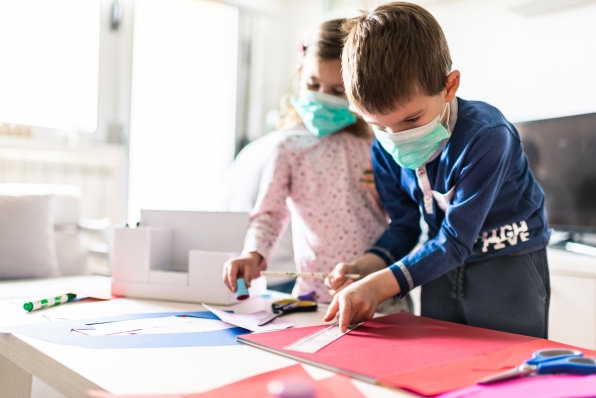How to get your kid to wear a mask
Several weeks ago, when the Centers for Disease Control and Prevention issued a recommendation that everyone over the age of two wear masks in public, my husband and I got a mask for my four-year-old daughter. We bought a cotton one with a pink flowery pattern that abides by the guidelines that the American Academy of Pediatrics issued to “securely cover the nose and mouth and stretch from before the ear to the other side.”
The problem is, she refuses to wear it. She complains that she can’t breathe, and she doesn’t like how the elastic bands tug at her ears. What’s a parent to do?
We sat down with Dr. Julia Sammons, the director of the department of infection prevention and control at the Children’s Hospital of Philadelphia, about how to help children adjust to wearing masks. She points out that children’s hospitals have a lot of expertise in helping children handle experiences that are difficult and frightening, such as using an IV drip or preparing to do an MRI. In these cases, doctors and nurses spend a lot of time talking to children, familiarizing them with the procedure, and even using play to help them become more comfortable. “All of these strategies can be applied to helping them wear a mask as well,” she says.
Know the rules
Before you jump into getting your child a mask, familiarize yourself with best practices. For starters, children under the age of 2 should not wear masks, because they may suffocate.
The American Academy of Pediatrics (AAP) explains that children do not need to wear masks if they can be kept at least six feet away from other people. Kids will have to wear masks at the pharmacy or grocery store, where social distancing is difficult. But as parks become crowded with people during the summer months, you might find that your child needs to wear a mask outdoors as well.
There is a clear protocol for wearing a mask, according to the AAP. You should wash your hands before you put on a mask and after you take it off. You should wash the mask after each time you wear it. And you should not wear it while eating or drinking. Masks should not be touched when they’re on, so you may have to remind your child not to touch her face while wearing her mask. The AAP says children should not wear a mask if it “causes the child to increase risk of getting exposed to the virus because they are touching their face more frequently.” The AAP has more specific guidelines for children with special needs, which you can check out here.
Start with yourself
As a first step, Sammons says it makes sense to wear your mask around your child. You might start by doing it around the house for brief stretches of time, simply to normalize the experience. “This is a new, unprecedented experience for all of us,” says Sammons. “It will make your child more comfortable to see other people wearing masks. You might even show them pictures of other children wearing masks as well.”
Personally, I’ve had to work hard to set a good example for my daughter. In the past, I’ve complained about how uncomfortable it feels to go outside in a mask. Now, I try to talk about how important it is and how I’m adjusting my mask to make it fit better before I go out.
Speak plainly
If your child asks about why we need to wear masks, experts say you should be straightforward about how masks help to curb the spread of the coronavirus by catching germs that come out of a person’s nose and mouth. My daughter responded particularly well when I talked about how this can be a way for her to protect other people in our community, and she was more eager to wear her mask after that chat. “I think it’s possible to be open with children with the coronavirus and talking to them about it in age-appropriate terms,” says Sammons. “But you can also make mask-wearing fun.”

Make it fun
To that end, Sammons says that parents can use play to help children adapt to wearing masks. As a mother herself, she talks with her kids about how they can pretend to be superheroes in their masks. “You can use any sort of game that your child will respond to,” says Sammons.
I found that it was helpful to turn mask-making into a craft project. My daughter and I spent an afternoon cutting up some of her old clothes and reconfiguring them into a mask she designed herself based on one of the many DIY mask designs available on the internet. We used stretchy materials in a pair of leggings to create ear straps and cut out the ruffle from a sundress to create a little piece that goes over her mouth and nose. She then used markers to color rainbows all over it. She was proud of her handiwork, showing it to her friends and teachers on her class’s Zoom meeting.
Sammons says this can be a good way to allow a child to feel like he or she has ownership of their mask. (However, as caveats, she says that the most important thing is that the mask fits properly, and she cautions against using any embellishment or decoration that will prevent you from washing the mask.)
Consider fit
When it’s time to get a mask for your child to wear on trips out, it’s important to think about how well the mask fits. “There are many materials and mask designs on the market,” Sammons says. “Whatever you choose, make sure that the mask covers the child’s mouth and nose. Otherwise, it will not actually help prevent the spread of the virus. The mask shouldn’t hang below the nose, in what I call the ‘mustache mask.’”
The vast majority of masks on the market right now are designed for adults and will be uncomfortable for a child. In general, those who have created masks for children say that children under the age of four need a mask that is 4 inches by 6 inches in size, with straps that are about 5 inches long that can go around their ears. Children between the ages of 4 and 12 need a mask that is 5 inches by 7 inches, with straps that are about 6 inches long.
?? Any medical personnel ??
If you’d like a headband for your mask PLEASE dm me your address & how many you’d like!! They are absolutely free!! We’re just trying to help in any way we can ?? pic.twitter.com/XblvNdwMNd
— ??a?le? (@hayleyalden33) April 4, 2020
Some children don’t like the feeling of elastic tugging at their ears. Healthcare workers in hospitals have landed on a clever idea: Get a headband and sew two buttons on the side of it behind the ears. Sammons says this will work with kids as well, given that you find a headband that will actually fit snugly on their heads. You can easily find children’s headbands on Amazon or your local pharmacy. (And if you have a child who doesn’t like the idea of wearing a headband, you can call it martial arts headgear.)
Listen to their preferences
Talk to your child about what kind of pattern or colors she might want on her mask.
If you’re planning to make a mask yourself, you can either buy fabric from online craft stores in fun colors and patterns, or you can do what we did and cut up clothes that your child has grown out of. It might be a nice way to repurpose a favorite outfit your child cannot wear anymore. In terms of patterns, there are several floating around online. This simple one takes about 10 minutes to make with a sewing machine.
If you’re more interested in buying a mask, you could try Etsy, which has a wide range of designs for kids available now, including some that are covered with cute patterns and characters, such as Marvel superheroes and Winnie the Pooh.
In preparation for the reopening of schools, several larger companies have begun offering masks for preorder. Vistaprint has $13 kids’ masks with an adjustable strap that will ship out at the end of May. You can get a “surprise variety pack” of five kids’ masks from Old Navy for $12.50, which will be shipped out in mid-June. Disney is selling sets of four for $19.99 in three different sizes, with characters from films such as Frozen and Star Wars, though it has not yet announced when they will ship out.
Keep trying and trying
And what happens if your child just throws a tantrum and refuses to wear a mask?
Sammons says that this happens with many children who don’t want to go through with uncomfortable, but medically-necessary, procedures at the hospital. When it happens, don’t try to force the issue (and don’t take your child to a place where masks are necessary). Instead, change the topic and do something else. Come back to the mask idea later, perhaps with a new game or a different way of framing mask-wearing. Your child could well come around the 2nd or 3rd (or 10th) time you bring it up.
(32)



